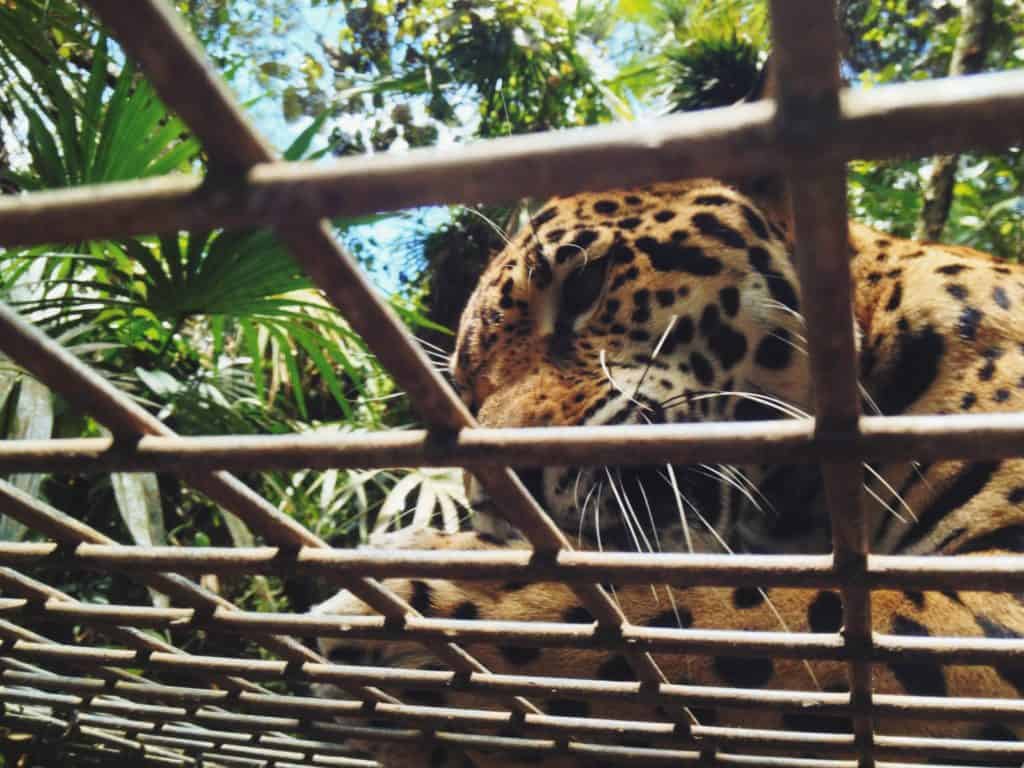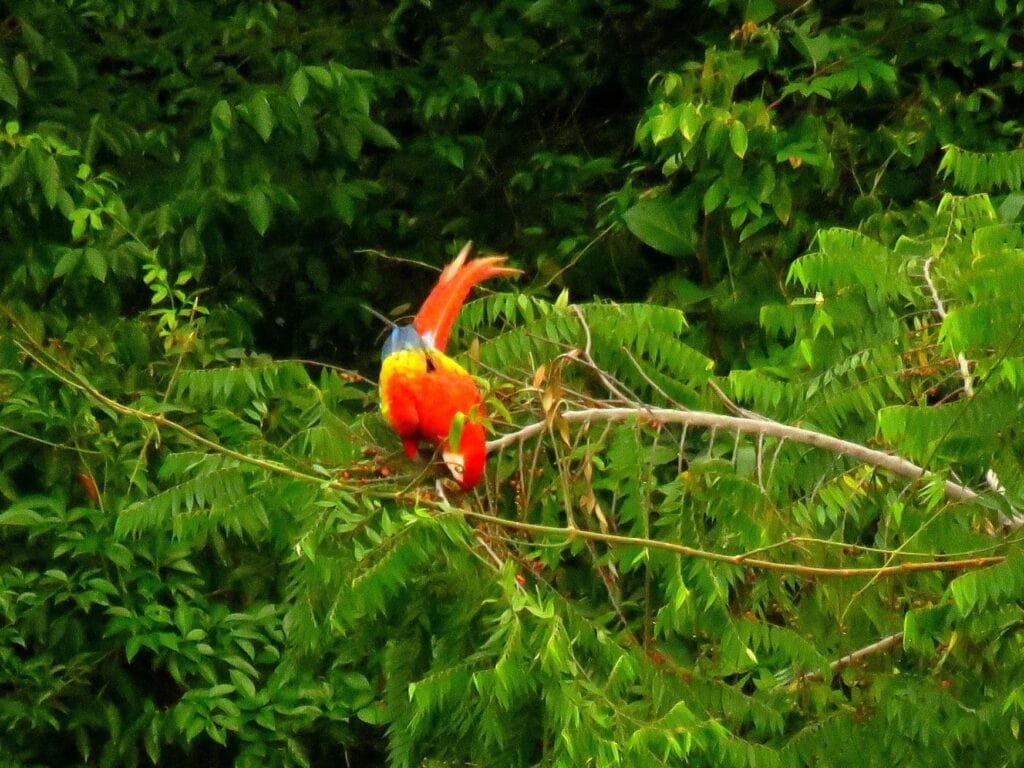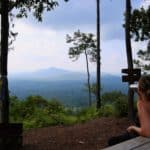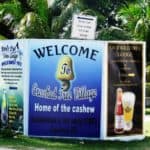Belize’s rich cover of rainforest and abundant coastal water contain numerous national parks, nature reserves, and wildlife sanctuaries that host many Belizean animals in their unspoiled natural habitat. This means that visiting Belize will surely involve encountering a few of its amazing native birds, mammals, reptiles, amphibians, and more.
Related: Top Belize Eco-Adventures and Birding in Belize
Here are 10 wild animals that are a must-see when in Belize. I recommend you explore the list below and see where they can be found so that you can plan your trip accordingly.
Jaguar

The magnificent Jaguar is so revered in Belize that it has an entire preserve to its name (Cockscomb Basin Jaguar Preserve)! The largest, most powerful cat in the Western Hemisphere, the jaguar can be found in Belize’s lowlands and along the coast. Most of their food source is smaller animals such as the peccaries and armadillos in the area. But they hunt for everything from mice to tapirs, and are even known to wrestle with crocodiles! Because they are nocturnal, jaguar are elusive to spot in the wild, but there is a guaranteed way to see at the Belize Zoo.
Howler Monkey

With their distinctive howl, often coming from up to a mile away, the Black Howler monkeys of Belize make themselves heard before they can be seen. The largest monkeys in Belize, they can grow up to 3 feet, and they often congregate in packs of 4 to 8. Guaranteed up-close and personal sightings can be had at the Community Baboon Sanctuary in the Belize River Valley. Be sure to look up in the trees and you’ll catch sight of a few playful monkeys darting from branch to branch, or perched solidly eating some fruit and leaves.
Sea Turtles – Green, Hawksbill and Loggerhead

Belize boasts three species of sea turtle: green, hawksbill, and loggerhead, but sometimes, an Olive Ridley will make its presence known too. And one of the best experiences is to see sea turtles underwater grazing on the sea floor, nibbling away at the turtle grass. They also often come up for air and are an adorable experience for all ages! For this, seek out snorkeling trips to Belize’s atolls or protected marine areas such as the Hol Chan Marine Reserve and the South Water Caye Marine Reserve.
Baird’s Tapir

Another of Belize’s beloved national symbols, the Baird’s Tapir is an intriguing creature. Known as the ‘mountain cow’, the tapir lives in the forest, feeding on grass, leaves, fruits and sometimes, a little bit of produce from nearby farms if they step out of their home! They can grow up to 6 feet in length and weigh up to 500 lbs. Despite their bulk, they are agile and excellent swimmers and climbers. The tapir has a distinctive short snout and stout body often compared to a pig’s. It is the largest land mammal in Central America.
Antillean Manatee

The largest of all manatee species, weighing between 800 to 12,000 pounds, this sub-species of the West Indian Manatee, the Antillean, is a protected animal of Belize. The country is believed to have one of the healthiest populations of this particular species, and an encounter with this magnificent creature is magical. These ‘sea cows’ float gently, only coming up for air every so often as they graze on seagrass along the seafloor. They can also be found in fresh or brackish waters. Manatees can be spotted in Caye Caulker, Monkey River, Placencia, and Sarteneja.
Southern Stingrays

If you ever spot nurse sharks, you’ll see that they are often accompanied by a number of Southern Stingrays as well. These large, flat, diamond-shaped fish have a whiptail, and often burrow themselves in the sand and can be missed during a routine swim or snorkel. However, they often accompany the eager nurse sharks at feeding time, feasting on scraps that fall from the boats and putting on quite the show. Rays can be easily spotted near Ambergris Caye or Caye Caulker but you can also see them all over Belize, including near Tobacco Caye.
Keel-billed Toucan

The national bird of Belize, the Keel-Billed Toucan is a distinctive bird with a large, colourful beak. Yellow, orange, green, red and black splashes of colour adorn this distinctive bird, which has a distinctive frog-like call. They can be found throughout the forests of Belize, and they nest in holes in tree trunks. In fact, they are closely related to the woodpecker. The Toucan is distinctive for only occurring on this side of the world.
Nurse Sharks

About 10 minutes away from the Hol Chan channel is another guaranteed encounter with more wildlife, in the form of nurse sharks. Capable of growing up to 14 feet in length, nurse sharks have strong jaws filled with thousands of tiny serrated teeth. While they are primarily nocturnal feeders, a lot of fishermen back in the day would clean their conch and other catch at this particular spot in the water, and over time, the sharks became accustomed to guaranteed feedings. Now, these ‘puppies of the sea’ can tell when boats have arrived to the area, and will come swimming by in clusters near the boat, hoping for some leftover fish scraps!
Scarlet Macaws

Lush scarlet plumage and a distinctive cry make the Scarlet Macaw a must-see in Belize. A member of the parrot family, the scarlet macaws prefer higher elevations and river forests. They also nest in holes in tree trunks, and their eggs and hatchlings are sadly very much coveted by poachers. In an effort to preserve these magnificent birds, organizations such as the Friends for Conservation and Development (FCD) joined efforts to protect these birds in their natural habitat during nesting and hatchling season. Camping at the base of the trees where they nest, volunteers and rangers warded off poachers, season after season, ensuring the species’ survival in Belize, and increasing the number of birds from a mere 24 at one time to over 1000 in a few years!
Crocodiles – American and Morelet

There are two different types of crocodiles in Belize: American and Morelet. Morelets are primarily found in freshwater, and the American crocodile is more suited to salt water. It is estimated that 1,000 American crocodiles remain in Belize, one of the largest populations of this threatened species. These apex predators are constantly under threat by humans and loss of habitat (mangrove swampland) and encounters with them in unexpected places can happen. Visitors can often spot these large creatures sunning themselves on the bank of the lagoons on Ambergris Caye. Morelets can be seen along the banks of the New River in the northern Orange Walk district.
Where can you easily spot Belizean animals?

While the Belize Zoo doesn’t have nurse sharks, stingrays, sea turtles or manatees, it does house an incredible array of species native to Belize. If you do not encounter a Jaguar or Tapir, or even a howler monkey, a visit to the best little zoo in the world will show you these gorgeous creatures in their sprawling habitats. The Belize Zoo is distinctive for housing displaced animals, providing acres and acres of natural, untouched habitat where the animals may roam. A visit to the zoo will provide you with a lot more close-ups of wild, wonderful animals! Do consider a visit!





Leave a Reply